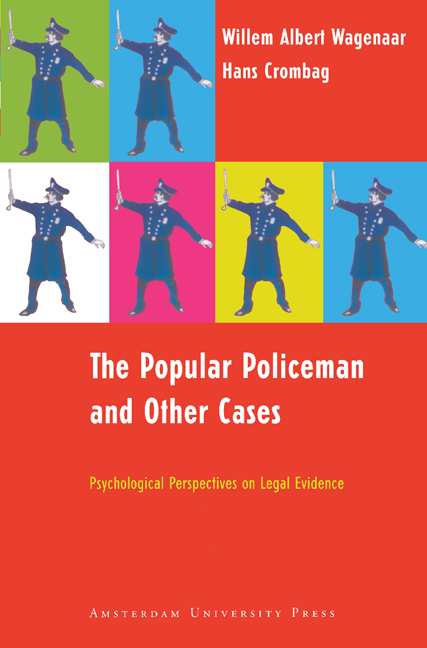Book contents
- Frontmatter
- Contents
- Foreword
- 1 Illegal Gambling or the Victory Travel Club
- 2 On Causal Reasoning or Death in the Warmoesstraat
- 3 Consumer Confusion or Potato Chips and Olive Oil
- 4 Fiction and Reality of ‘the Average Individual’ or the Case of Old Mr. Lane
- 5 Case Histories and Scientific Proof or the Case of JR
- 6 Not a Good Story or the Disappearance of Maddy and Vicky
- 7 Conflicting Scenarios or the Case of the Man who Needed a Companion
- 8 Two Processes Obstructing the Accuracy of Long-Term Memory or the Case of the Stolen Mercedes
- 9 Confessions after Repeated Interrogation or the Putten Murder Case
- 10 Collaborative Storytelling or the Artist’s Models and an Angry Neighbourhood
- 11 Allegation of Sexual Child Abuse in a Case of Disputed Visitation or Cindy's Story
- 12 Psychogenic Amnesia or the Case of the Amnesic Strangler
- 13 Obeying Reflexes or Death on the Climbing Wall
- 14 Visual Acuity or Shooting Mimi the Cat
- 15 Sexual Semiotics or the Case of the Popular Policeman
- Postscript: Psychological Expertise and the Law
- Bibliography
- Name Index
- Subject Index
2 - On Causal Reasoning or Death in the Warmoesstraat
Published online by Cambridge University Press: 16 February 2021
- Frontmatter
- Contents
- Foreword
- 1 Illegal Gambling or the Victory Travel Club
- 2 On Causal Reasoning or Death in the Warmoesstraat
- 3 Consumer Confusion or Potato Chips and Olive Oil
- 4 Fiction and Reality of ‘the Average Individual’ or the Case of Old Mr. Lane
- 5 Case Histories and Scientific Proof or the Case of JR
- 6 Not a Good Story or the Disappearance of Maddy and Vicky
- 7 Conflicting Scenarios or the Case of the Man who Needed a Companion
- 8 Two Processes Obstructing the Accuracy of Long-Term Memory or the Case of the Stolen Mercedes
- 9 Confessions after Repeated Interrogation or the Putten Murder Case
- 10 Collaborative Storytelling or the Artist’s Models and an Angry Neighbourhood
- 11 Allegation of Sexual Child Abuse in a Case of Disputed Visitation or Cindy's Story
- 12 Psychogenic Amnesia or the Case of the Amnesic Strangler
- 13 Obeying Reflexes or Death on the Climbing Wall
- 14 Visual Acuity or Shooting Mimi the Cat
- 15 Sexual Semiotics or the Case of the Popular Policeman
- Postscript: Psychological Expertise and the Law
- Bibliography
- Name Index
- Subject Index
Summary
At about 4:30 PM on 22 September 1997, a homeless, alcoholic man, whom we will call Van Eck, entered the police station in the Warmoesstraat in Amsterdam, loudly demanding that he be allowed to use the telephone to call someone. At first, police officer Abrams (a pseudonym) thought that Van Eck was drunk: he appeared ‘unstable on his feet’, but then his breath did not smell noticeably of alcohol. Officer Abrams pointed out that there was a public telephone booth nearby, but then Van Eck demanded a meal and a bed for the night in one of the detention cells. Officer Abrams told Van Eck that this was not possible and asked him to leave, which he refused. Abrams and his fellow officer Barends used ‘ mild force’ to persuade Van Eck to leave (the passages in quotation marks are quotes from an interrogation of Abrams, as reported in the affidavit of that interrogation). Once outside, Van Eck took a step forward and let himself fall forward on the sidewalk, but he pulled himself up and walked away.
At about 7:45 PM on that same day, officer Abrams and a colleague, on patrol in the neighbourhood, saw Van Eck leave a café and walk away with unstable gait, presumably intoxicated. At about 8:15 PM Van Eck again entered the police station, demanding food and shelter for the night, which was again refused. And again officer Abrams and a colleague led Van Eck out the door of the police station. Once outside he again let himself fall forward, pulled himself up and walked away. Not for long though; a few minutes later he was back inside the police station. After an agitated exchange, officers Abrams and Barends each took hold of one of his arms and led the struggling Van Eck with some force out the door. Once outside, Van Eck stood on the sloping wooden ramp in front of the door, facing the street. He turned around, obviously intending to re-enter, but by standing in the narrow doorway officer Abrams prevented this. Loudly arguing, Van Eck kept trying to push his way back in, but Abrams resisted his pushing. Suddenly Van Eck appeared to give up and let himself fall again, backward this time. He fell like a log, without apparent signs of trying to stay upright or breaking his fall.
- Type
- Chapter
- Information
- The Popular Policeman and Other CasesPsychological Perspectives on Legal Evidence, pp. 25 - 42Publisher: Amsterdam University PressPrint publication year: 2012



